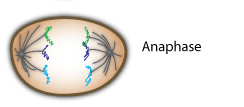Mitosis Definition
Mitosis refers to one of the processes of cell division.
Mitosis involves chromosomes, which occur naturally in pairs and which contain the organism’s genetic information.
In mitosis, chromosome pairs separate and then form new pairs.
Mitosis ensures that the new cell (called the daughter cell) has the same chromosome number as its parent cell.
So, genetic information is shared equally among new cells when mitosis occurs in complex organisms.
Mitosis – The Essential Principal
The most important point about mitosis is that the daughter cells receive exactly the same number and types of chromosomes as the parent cell.
So, the genetic constitution of the organism is maintained.
The Process of Mitosis – Step by Step
The process of mitosis consists of four basic steps:
- At the beginning of the division of the cell nucleus, each chromosome exists as a replicated structure. So, the DNA of the parent cell has already replicated before mitosis begins.
- Each chromosome then divides longitudinally (length-wise), forming two identical halves that separate from each other.
- The separated halves then move in opposite directions.
- Each of the chromosome halves becomes incorporated into the nucleus of one of the two new daughter cells that are formed.
Mitosis – The Scientific Stages
Scientifically speaking, mitosis consists of four stages.
The names of these four stages are:
- prophase
- metaphase
- anaphase
- telophase
The entire process of mitosis usually takes about an hour.
Prophase
Chromosomes condense and form distinct threads within the nucleus of the cell.
The chromosomes are already longitudinally double, meaning that they contain two identical halves.
Metaphase
The chromosomes move to the center of the cell.
The chromosomes then form a line in the center of the cell.
This line is exactly halfway from each of the two ends of the cell.
Anaphase
During this phase, the two parts of each chromosome begin to divide and move to opposite ends of the cell.
Each of these two parts of the chromosome is call a chromatid.
When the separation is complete, each chromatid becomes a new chromosome.
At the end of anaphase, there will be two identical groups of chromosomes at each end of the cell.
Telophase
During telophase, an envelope or sac forms around each group of chromosomes.
Each half of the cell forms a new nucleus, and the chromosomes condense and become less spindle-like.
This means that, when viewed under a microscope, the chromosomes will have changed in appearance.
At the end of telophase, the cell divides into two new cells.
Mitosis and Meiosis
Mitosis should not be confused with meiosis.
Meiosis halves the number of chromosomes, while mitosis maintains the number of chromosomes.
Exercises
- What is the basic principal of mitosis?
- What occurs during prophase?
- What occurs during metaphase?
- What occurs during anaphase?
- What occurs during telophase?
Answers
- The basic principal of mitosis is that daughter cells receive exactly the same number and types of chromosomes as the parent cell.
- During prophase, chromosomes form distinct threads within the nucleus of the cell.
- During metaphase, chromosomes form a line at the exact, equidistant center of the cell.
- During anaphase, the two parts of each chromosome (called chromatids) begin to divide and move to opposite ends of the cell, forming two identical groups of chromosomes at each end of the cell.
- During telophase, an envelope forms around each group of chromosomes. Each half of the cell forms a new nucleus. The chromosomes condense and the cell divides into two new cells.
You may also wish to visit our posts on cell differentiation, cell structure, and meiosis.



